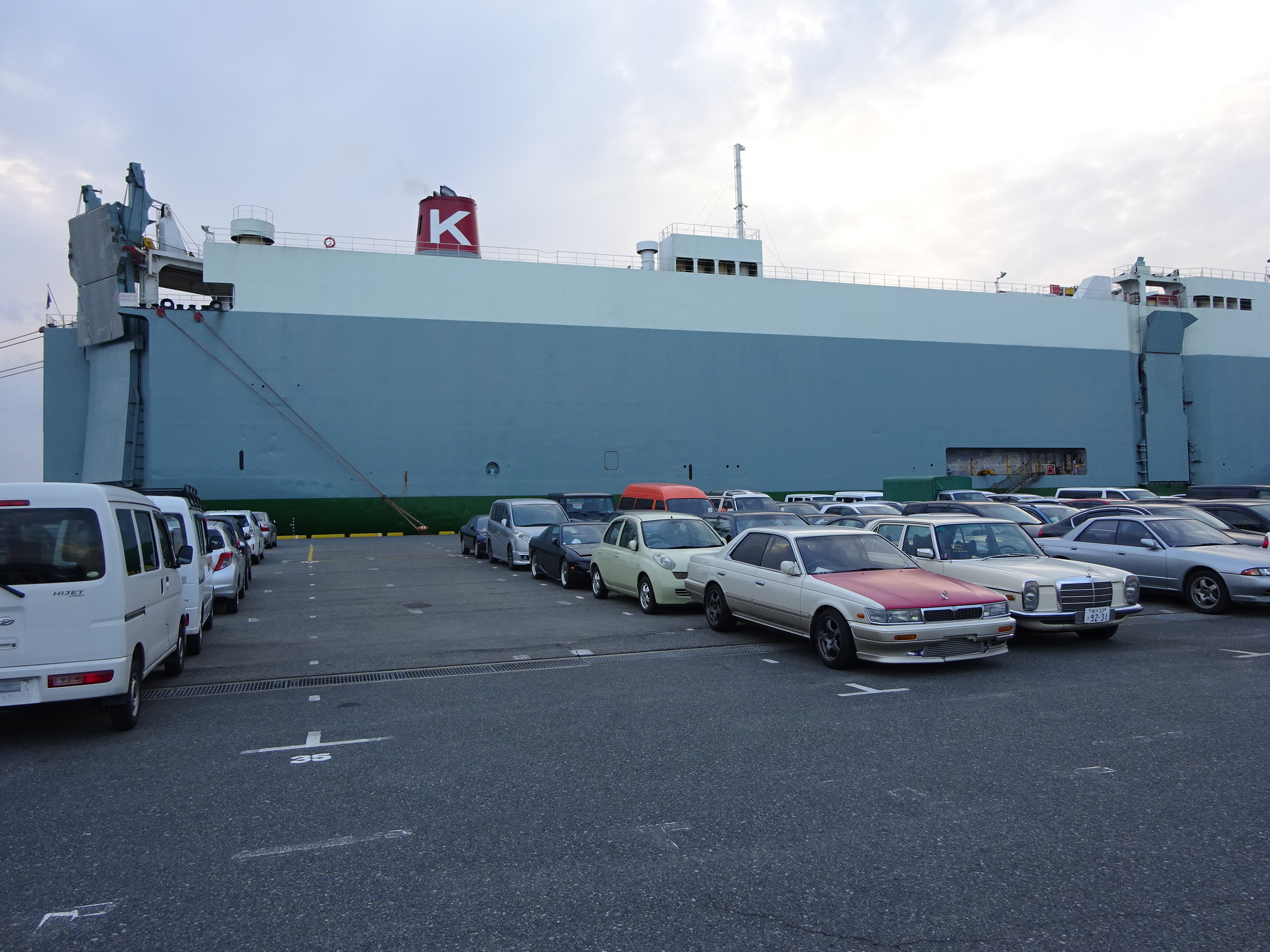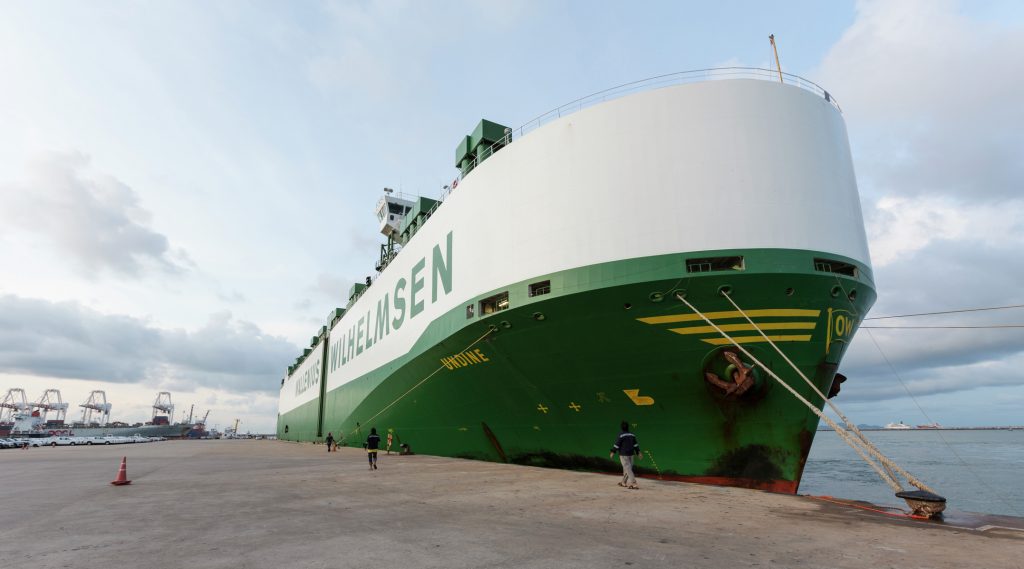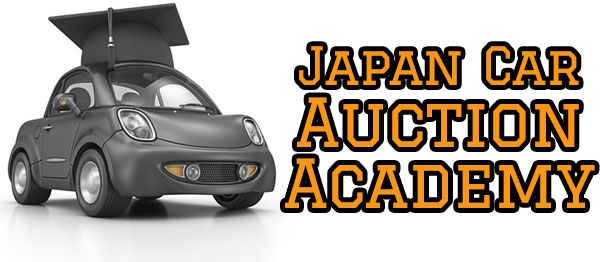
What is RORO shipping?
The easiest way to think about it is to imagine a RORO (also written "Ro-Ro") ship as a giant car ferry. Vehicles are driven on and off the ship by port workers called stevedores, hence the name — Roll On Roll Off.
Within the RORO world, there are two major divisions – the PCC (Pure Car Carrier) vessels that are for cars only, and PCTC (Pure Car Truck Carrier) carry both regular passenger cars as well as larger vehicles, like trucks and buses.
From your point of view as a customer, it makes no difference whether your car is shipped by PCC or PCTC. All you really need to know is that these ships are like giant floating parking lots that move new and used vehicles around the world.
What are the advantages of RORO shipping?
RORO shipping tends to be a better choice than container shipping for the majority of customers. But why is that? Let's explore these each of these in turn.
RORO shipping is often cheaper
First of all, RORO shipping tends to be cheaper. Since the cars are simply driven on and off, there is no need to use extra materials (like a container and materials to load the car), nor does it take as many man hours per car to prepare the vehicle for shipping.
Easy pick up at your end
When you get the car at your end, you can just go pick it up and drive it (or have it transported) away. There’s no need to extract it from a container, which can require some equipment and skill if you have more than 2 cars loaded in the container.
You can ship odd numbers of cars
Another advantage of RORO shipping is that you can easily ship single cars, or odd numbers of cars. Let me explain what I mean.
Let’s imagine the kind of cars you buy fit four per container. So what happens if you get three and want to stop? Well, you have to ship the container with those three, so the shipping cost per car will be 33% more than if you had four.
On the other hand, what happens if the cars you are interested in a few and far between? If you’re a low volume buyer like this, it could be quite a while before you have bought enough to fill your container. But with a RORO ship, we can book each car as you buy them — even if they only end up one per ship — so you can get a quicker, more efficient flow of cars.
Are there any disadvantages to RORO shipping?
There may not be a RORO service to your port
If you are shipping standard cars or other vehicles, the only reason you would not use RORO shipping is if there was no RORO ship going to a port near you.
The RORO shipping routes are very extensive. Add to that the fact that Japan is a major center of car manufacturing, which is why many RORO ships ply routes to and from Japan’s ports to service these big auto makers. However, there are a few countries or locations which RORO services are not available for. If you want to know whether your location has a RORO shipping option or not, make sure you contact us.
Loose or easily removable items can be targeted for theft
Occasionally, there are incidences of items being stolen from inside the car while it is in transit on the ship. This is a fairly rare occurrence, and we can help protect items in your car by disguising them or hiding them in the vehicle. Another alternative for a stereo would be for us to remove it and send it to you by airmail. Most customers do not consider this necessary, though.
Inner Cargoes not allowed
Sometimes you will find some removable parts or aftermarket parts inside the vehicle on auction pictures. Although they are included in the vehicle price, we are not able to leave them inside the car when we are loading on the vessel. It will be abandoned at the port or if you need them, you will need to let us know so we can separately send them by DHL or something. (The fee will be charged to you)
RORO shipping is not suitable for high-value vehicles
The fact that stevedores drive the cars onto the ship, and then they are accessible during the voyage means that RORO shipping is not suitable for high-value vehicles.
If a car is over 5 million Yen, we recommend you consider container shipping. For cars over 10 million Yen, you should definitely use the container shipping option. Then, for very expensive exotics and rare cars, we recommend air freight. Please contact us if you are considering purchasing high-value cars.
RORO bolster shipping (***Currently not Available***)
Some RORO shipping destinations allow us to ship non-moving cars on a bolster. This is particularly useful if you buy an accident-damaged car, or if you are buying very old cars that turn out not to run.
The usual solution for these kinds of cars would be to ship them in a container. However, with the extra loading costs and the extra expense of the container shipping itself, this is not a good option for shipping the odd car.
A bolster is a wheeled platform. The car is loaded onto it, and then the bolster itself is rolled onto the RORO ship. The shipping is calculated in the same way as for a standard car shipment (see below), but then an extra flat-rate charge is added for the bolster.
Calculating the RORO shipping cost
RORO shipping tends to be cheaper on a per-car basis than container shipping for most customers. So how is the RORO shipping cost calculated?
For a very small number of routes, the rate is quoted on a per-vehicle basis. However, usually it will be on a per-cubic meter basis. In fact, the shipping company will usually several per cubic meter (or “M3”) rates.
Calculating the Cubic Meter Size
The “M3” is calculated by multiplying the width, length and height of the car in meters. So the cubic meter volume is the size of the box of space the car fits into, rather than the exact volume of the car.
This will give you an idea of rough cubic meter sizes:
Classic Mini = 8.5 cubic meters.
Small sedan = 10 cubic meters.
Large sedan = 12 to 13 cubic meters.
Medium SUV = 14 to 15 cubic meters.
Large SUV = 16 + cubic meters
Example RORO shipping cost calculation
Here is a (fictional) example of a three-tier rate system:
Vehicles up to 1.5 m in height = $64.55 per cubic meter
Vehicles between 1.5 m - 1.85m in height = $72.55 per cubic meter
Vehicles over 1.85 m in height = $83.45 per cubic meter
For each of these prices, the dollar value is the US Dollar (USD). That does not mean you will be billed in US Dollars. This is just the unit of currency used for the calculation.
So, let’s imagine we have 2 vehicles we are shipping to you: One is a small sedan which is exactly 10 cubic meters and is under 1.5 meters high. The rate for this car will be $64.55 per cubic meter.
The other vehicle is a 12.35 M3 SUV that is 1.7 meters high. The rate for this SUV will be $72.55 per M3.
Now, let’s calculate the shipping cost for each:
The Sedan
10.00 M3 * $64.55 = $645.50
The SUV
12.35 M3 * $72.55 = $895.99
Now, it is a little more complex than this, as there are likely to be a few small charges, such as the BL fee (often 25 US Dollars) added on, but doing the cubic meter rate calculation will give you a figure that will be very close to the final one.

How do I pay for the shipping?
For most shipping destinations, you will be able to pay the shipping company directly at your end in your currency a short while before the ship itself arrives.
The shipping company will do the calculation above to get the US Dollar cost, convert that to your currency and send you a bill. If you are not in the US, this obviously means that what you end up paying in your currency will vary depending on the exchange rate.
When you can pay for shipping at your end, this is called “FOB” (Free On Board) shipping.
For some destinations shipping charges have to be paid by the shipper — Integrity Exports. Again, the shipping company will calculate the charge in US Dollars, but then they will convert this into Japanese Yen and send the invoice to us. We pay the shipping company, send you an invoice and bill you in Yen. You must transfer the amount due before we can send documentation for the car.
When shipping is paid by the shipper like this, it is usually called “CIF” (Cost + Insurance + Freight) shipping.
Questions?
To find out about specific shipping costs for your country, please contact us and tell us:
- The destination country and (if possible) port.
- The make, model and year of vehicle you are thinking of buying.
If you have any questions about container or RORO shipping, please contact us and we will be happy to help.

We find that the most successful importers really understand how it all works - from the auction to the ship and beyond. Don't get left behind!


